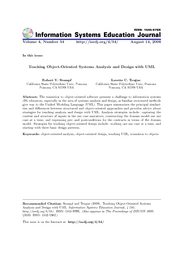Volume 4
Volume 4, Number 54 |
August 14, 2006 |
Abstract: The transition to object-oriented software presents a challenge to information systems (IS) educators, especially in the area of systems analysis and design, as familiar structured methods give way to the Unified Modeling Language (UML). This paper summarizes the principal similarities and differences between structured and object-oriented approaches and provides advice about strategies for teaching analysis and design with UML. Analysis strategies include: capturing the content and structure of inputs in the use case narratives, constructing the domain model one use case at a time, and expressing pre- and postconditions for the contracts in terms of the domain model. Strategies for teaching object-oriented design include: working one use case at a time, and starting with three basic design patterns.
Keywords: object-oriented analysis, object-oriented design, teaching UML, transition to objects
Download this issue: ISEDJ.4(54).Stumpf.pdf (Adobe PDF, 17 pages, 811 K bytes)
Preview the contents: Stumpf.j.txt (ASCII txt, 35 K bytes)
Recommended Citation: Stumpf and Teague (2006). Teaching Object-Oriented Systems Analysis and Design with UML. Information Systems Education Journal, 4 (54). http://isedj.org/4/54/. ISSN: 1545-679X. (A preliminary version appears in The Proceedings of ISECON 2005: §3533. ISSN: 1542-7382.)
